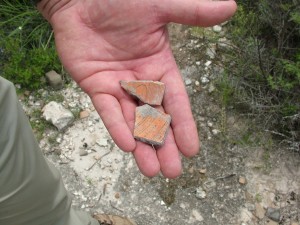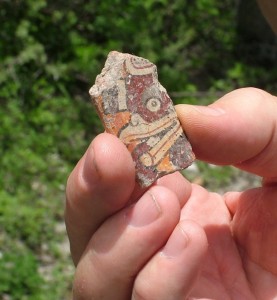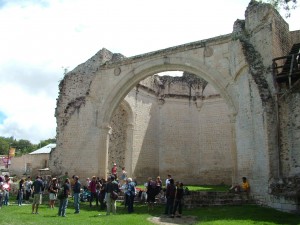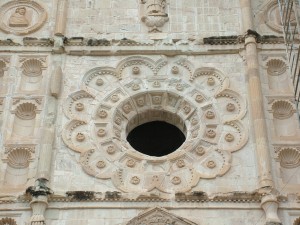On this page we are assembling resources relating to our excursion to Coixtlahuaca, in the Mixteca Alta. It is our hope that these materials might be useful in preparation for our excursion and as resources for developing curricular materials, if you choose.
Here is an image of the setting of Coixtlahuaca, both its archaeological site, which is spread over much of this countryside, and a part of the modern settlement. A blog from 2009, written by an archaeologist who was working with Dr. Steve Kowalewski at Coixlahuaca is worth a visit.
As we will see in the bits of pottery (potsherds or “sherds” for short) still lying on the ground at the archaeological site, the Nahuas (or Aztecs) were a presence here, whether as colonizers extracting tributes or as residents of a trading colony.

Examples of sherds of Nahua (or Aztec) origin in Coixtlahuaca, identified by John Pohl (Photo, S. Wood, July 2010)
It may have been Aztecs who brought this obsidian blade (below) to Coixtlahuaca all the way from Pachuca (state of Hidalgo), according to John Pohl.

Pachuca-origin obsidian blade in Coixtlahuaca identified (and held) by John Pohl (S. Wood, July 2010)
Pottery from Yanhuitlan, also an important pre-Columbian center in the Mixteca, is similarly abundant. It is characterized as red-on-cream.

A variety of sherds on the ground in Coixtlahuaca, including a larger piece with red lines on cream, probably from Yanhuitlan, according to John Pohl. (S. Wood, July 2010)
Below is a photo of polychrome (multicolored) pottery, which Pohl says appears to depicts a cotton ball.

Polychrome sherd in Coixtlahuaca identified by John Pohl as possibly a cotton ball (S. Wood, July 2010)
John also found a sherd with what may be a fragment of a turkey head. This type of iconography can also be found on codices, an example of intertextuality between ceramics and documents. Some may have appeared on murals, as well.
The Codex Mendoza depicts the Aztec conquest of Coixtlahuaca in pre-Columbian times, suggesting that central Mexicans subjected this region to their extraction of tributes. This is one more example of the truth that the people of Oaxaca had already been accustomed to living under foreign rule (even if from other Mesoamericans) prior to the arrival of Europeans.
Incidentally, as we see in the Codex Mendoza detail, the place glyph for Coixtlahuaca consists of the elements coatl (serpent) and ixtlahuatl (plain). The locative -can (which lost its “n” and became -ca) is not depicted. The Mixtec people had their own name for this town; it was the Aztecs who named it Coixtlahuaca, and that stuck — through Spanish colonial times and up to the present day. Here is another version of the glyph, the far right element of these four place glyphs. Here we learn that the Mixtec name for Coixtlahuaca is Yodzo Coo, “Plain of the Snake.” The Aztecs probably simply translated the placename from Mixtec to Nahuatl. Rattlesnakes are well known in the Mixteca Alta. When Yucundaa, a site we used to visit, was being excavated, archaeologists found a nest of rattlers near what once was the colonial chapel.
Coixtlahuaca is famous for its “lienzos” or pictorial manuscript-cloths, which one might include in the more general group, “codices.” They were authored by indigenous painter-scribes in the sixteenth century. They capture a great deal of pre-Columbian political history, and continue into the Spanish colonial era. The Lienzo de Coixtlahuaca (actually one of several from this valley) is interesting for its depiction of horses, for one thing. One can see a detail of the pictography in this except from an article by Dr. Bas van Doesburg, one of our faculty for next week. Aztecs supposedly visited this community in 1503 and 1518 (prior to European contact) to ratify the territorial boundaries, and Spanish judges visited did the same in 1527, 1542, 1544, and 1552, according to van Doesburg.
Another one of the Coixtlahuaca lienzos is the mid-sixteenth-century Lienzo of Ihuitlan, held by the Brooklyn Museum (available here in a facsimile image that is downloadable). This is typical of the Coixtlahuaca valley documents with its extensive genealogical elements (couples seated together on jaguar mats, sharing rule, and descending from earlier ruling couples, connected by footprints), and cartographic elements (with placenames and other landscape features).
Another one of the Coixtlahuaca lienzos is the Lienzo de Tlapiltepec. A glimpse of essay in Spanish about this lienzo, with an image of a detail, is offered on line. (To see the full essay, one has to purchase the book.) The detail includes information about the parents of the leader named Atonal. This leader is the one, above, who was shown in the Codex Mendoza as having been executed by the Aztecs in their conquest of Coixtlahuaca. This is an example of the ways some of these ancient pictorials intersect.
The lienzo of San Mateo Tlapiltepec, also known as the Codex Richards, one of the lienzos of the Coixtlahuaca valley, is currently located in a museum in Ontario, Canada. It was sold to a collector in the year 1900. The comunity would like to have it back, but they estimate it would cost $20,000,000 USD to recuperate it, money they do not have. An article in Spanish from 2011 explains this predicament. This raises the issue of potential “repatriation,” or the return of the pictorial to the community, which very few museums dare to undertake.
A free, full-text essay about the Coixtlahuaca lienzos, in Spanish, includes an image of a Native lord being hanged in front of the colonial church. A Spaniard (in his curule chair, beard, and hat), sits above and directs the hanging.
The Spanish colonial church at Coixtlahuaca, dedicated to San Juan Bautista, included a large open chapel still visible today.



